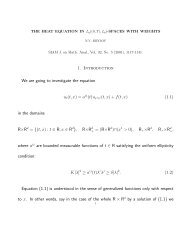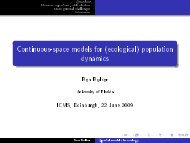Luc TARTAR Compensated Compactness with more ... - ICMS
Luc TARTAR Compensated Compactness with more ... - ICMS
Luc TARTAR Compensated Compactness with more ... - ICMS
Create successful ePaper yourself
Turn your PDF publications into a flip-book with our unique Google optimized e-Paper software.
I hope that multi-scales H-measures (or better adapted improvements)<br />
will permit to prove (or disprove) a few formal constructions<br />
where a few scales interact, in particular in boundary<br />
layers. There are two important problems for which one<br />
has conjectured boundary layers <strong>with</strong> a few scales, one concerning<br />
Joe KELLER’s GTD (geometric theory of diffraction),<br />
and one concerning STEWARTSON’s (1925–1983) proposal of a<br />
triple deck structure for some boundary layers in hydrodynamics,<br />
but there are plenty of other problems where such ideas<br />
should be tested, like for understanding the size of domains<br />
and the movement of their (grain) boundaries.<br />
A few years ago, Amit ACHARYA and I were quite puzzled to<br />
hear someone (who had received the Nobel Prize in Physics in<br />
the 1990s) mention in his talk that “biology is <strong>more</strong> difficult<br />
than physics because problems in biology involve many scales,<br />
while problems in physics always involve one scale”!<br />
A few years before, I had heard a very interesting observation<br />
in a talk by “Raj” RAJAGOPAL. Although he was working at<br />
University of Pittsburgh at the time, I mostly met him abroad,<br />
and his talk was given in Paris when the laboratory now called<br />
LJLL (Laboratoire Jacques-Louis Lions) was still located in<br />
Jussieu (before moving to Chevaleret, and back to Jussieu).<br />
Raj started <strong>with</strong> an intuitive way to distinguish gases, liquids,<br />
and solids: if one puts a small amount of gas into a container,<br />
the gas soon fills the entire container; for a small amount of<br />
liquid, it approximately keeps its volume and soon occupies all<br />
the volume of the container below an horizontal plane, because<br />
of gravity; for a small solid, it approximately keeps its shape,<br />
and soon finds a position of equilibrium near the bottom of the<br />
container, again because of gravity.<br />
22
















